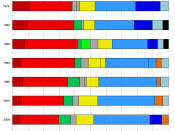Question 2
Trade protection in agriculture by European Union and the United States results in gains for some and loss for others. Evaluate the impact of US Farm Policy or EU Common Agriculture Policy on developing countries.
The European Union (EU) is the agricultural leader among developed countries in international trade. It is well-known as a world's major food exporter. In 2010, for example, its agricultural exports, mainly processed foods like beverages, essential oils and food preparations, reached the record level of â¬91 billion (Fritz, 2011). Nevertheless, its position as the world's largest importer, mainly from developing countries, is far more significant. This was proven where around 72% of its agricultural imports are originated from developing countries, which accounted on average US$83 billion worth of agricultural products over the period of 2007 to 2009. This rate is higher than the combined imports of the United States, Japan, Canada, Australia and New Zealand from developing countries, which is around 38% and accounted on average US$64 billion for the same period� (Matthews, 2010a; European Commission, 2010).
For instance, soya, the single most important agricultural commodity imported into the EU, is mainly supplied by Brazil and Argentina. Other important tropical products include coffee, bananas, cocoa beans and palm oil supplied almost entirely by developing countries as well (Fritz, 2011).
The EU's Common Agricultural Policy (CAP) was introduced in the early 1960s at a time where farming accounted for a large share of Europe's GDP and population (Bureau & Matthews, 2005). The purpose of forming this policy is to promote agriculture throughout the EU by influencing prices, output and farmers' incomes, including provision to protect the rural and agricultural commodity. Apparently, the CAP is introduced based on two pillars, with each pillar funding different policies in different ways. Pillar 1� comprises both direct payments...


